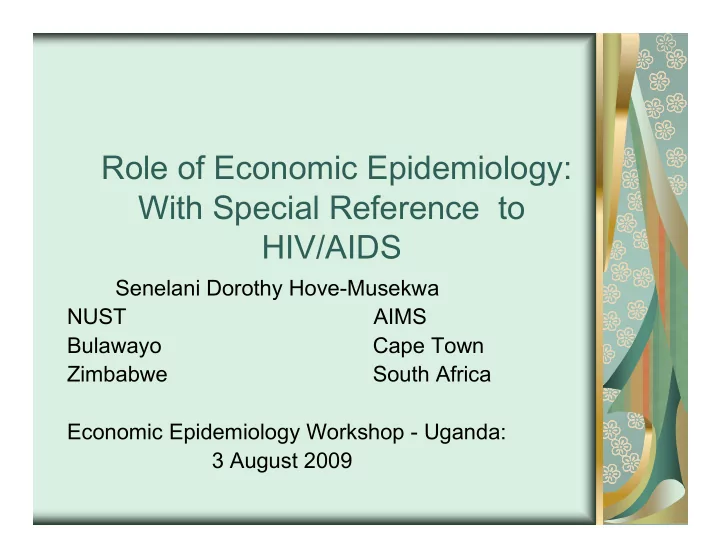

Role�of�Economic�Epidemiology:� With�Special�Reference to� HIV/AIDS Senelani�Dorothy�Hove�Musekwa NUST�����������������������������������������AIMS Bulawayo�����������������������������������Cape�Town Zimbabwe����������������������������������South�Africa Economic�Epidemiology�Workshop�� Uganda:���������� 3�August�2009
Outline�of�presentation Definitions Trend/Aim/Benefit Prevalence�dependence Effects�of�individual�behaviour Economic�impact�of�HIV/AIDS Concepts�from�mathematical� epidemiological�models Measuring�economic�impact
Outline……. Economic�evaluation�concepts Conclusion�
What�is�Economic�Epidemiology? Economic�epidemiology is�a�field�at�the� intersection�of�epidemiology�and�economics� Its�premise�is�to�incorporate � principles�of�individual�behavior � incentives�for�healthy�behavior� (Wikipedia) � resource�optimization� � simple�economics into�epidemiological�models�and � the�dynamics�of�infectious�diseases into�health�economics
Epidemiology It�is�the�basic�science�of� public�health which�is�the�science�and�art�of������������������������������ � preventing�diseases������������������������������������� � prolonging�life���������������������������������������������� � promoting�health� through�organised�efforts�and�informed� choices of�governments,�individuals,� communities,�societies�and��organisations� (both�private�and�public)��(Winslow,�1920)�
Epidemiology DEFINITION:� The� study of�the� distribution ,� frequency and� determinants of�health�problems�and� disease�in�human�population PURPOSE:� To�obtain,�interpret�and� use�health�information�to�promote� health�and�reduce�disease�(that’s� public�health) Public�health� means� public�policy
Economics� Economics is�the�social�science that� studies�the�production,�distribution,�and� consumption of�goods and�services. Economics�aims�to�explain�how�economies work�and�how�economic�agents interact.� (Wikipedia) Economics�plays�a��big�role�in� public� policy while�epidemiology��says a�lot�about� the�dynamics�of�infectious�diseases
What�is�the�trend? Epidemiological�models�do�not�real�take�� account�of�economic�constraints�or� incentives�faced�by�individuals�and�policy� makers Economic�models�mostly�do�not� incorporate��the��dynamics�of�disease. Biological�and�economic�epidemiology� make�different�predictions�of�disease� occurrence�because�of�their�different� predictions�about�the�relationship�between� prevention�and�prevalence�(Philipson,� 1999)
Hazard�rate�into�infection�is�an� increasing� function� of�prevalence�in�epidemiological�analysis� while�it�is�a� decreasing�function�of�prevalence� in� economical�analysis More�people�infected�in�the�population�leads�to� more��susceptibles infected�later Susceptibles face�a�larger�risk�of�infection�and� therefore�their�demand�for�prevention�becomes� high�and�thus�reduce�infection�hazard No�real�collaborative�work�between�biologists,� economists�and�mathematical�epidemiologists� (Klein�et�al�2007)�
Aim� Have�an�interdisciplinary�approach�to�� manage�the�complex�interaction�of� mathematical,�economical,� epidemiological�and�biological� considerations�in�the��emergence,� persistence�and�spread�of�infectious� diseases�
Benefits:�Epidemiological�models Provide�a�foundation�for�public�policy� models�of�disease�treatment�and� prevention�programs Estimate�disease�incidence�and�prevalence� (number�of�individuals�per�unit�time�who� are�infected) Identify�groups�of�the�population�which��are� most�at�risk�of�contacting�the�disease Estimate�parameters�defining�strategies�to� counteract�the�epidemic
Benefits:�Policy�makers Require�to�make� informed�decisions to� determine�the�best�way�of�allocating�scarce� resources�for�the�different�programs�of� prevention�and�treatment Need�to�know�the� benefit��and�cost�of� each�program that�produces�the�greatest� reduction�in�infections,�morbidity�and� mortality�given�resource�constraints
Benefits�contd…. Reasonable�assessments�of� program�costs�and�benefits�are� required�to�make�rational�policy� decisions Improves�policy�responses�to� epidemic�diseases�by�providing� clear�tools�for�thinking�about�how� certain�actions�can�influence�the� spread�of�disease�transmission.�
Benefits�contd…. Optimal�strategies�and� policies�are�needed�to�control� the�spread�of�diseases Economic��evaluation concepts�are� therefore�required�to�help�to�identify,� measure,�compare�costs�and� consequences�of�alternate�strategies
So�what? Economic�epidemiology�strives�to� incorporate�different�types�of�behavior� responses�(individual,�policy�maker)�into� epidemiological�models�to�enhance�a� model’s�utility�in�evaluating�control� measures. Need��understand�what�is�involved�and� how�it�can�be�done�to�make�sure�that�this� ‘ marriage ’ between�economics�and� epidemiology�can�work
Principle�of�Individual�Behaviour� The��field��is�dependent�on��the�idea�of� prevalence� Epidemiological�analysis�discusses�how� various�patterns�of�behaviour�affect�the� progression��and�occurrence�of�the�disease� but�does�not�analyse�the�implications��and� effects�of���this�behaviour�change� Limiting�the�spread�of�a�disease�at�the� population�level�requires�changing� individual�behavior,
This�depends�on�what�information�(general� and�specific)�individuals�have�about�the� level�of�risk�because�individuals��change� their�behavior�as�the�prevalence�of�a� disease�changes� Decisions�affecting�health�also�dependant�� on�objectives�and�constraints�– not�normal� taken�care�of�in�health�policy�formulation��� – economics�of�the�home � other�things�to�take�care
When�disease�disappears�the� demand�for�vaccines�also�does�so Decline�in�vaccination�then�allows�the� disease�to�return Supply�side�is�also�affected�since� demand�for�the�supplier�is�also� eradicated�
Example Massive�campaigns�of�boiling� drinking�water,�wash�your�hands� before�you�eat,�don’t�shake� hands,�etc��to�reduce�cholera� transmission�can�reduce�the�� effects�of�the�epidemic��and�this� might�lead�to�relaxation�of�the� above�campaigns
People��tend�to�ignore�a�disease�if�risk�is� low,�but��if�the�risk�of�infection�is�higher,� individuals�are�more�likely�to�take� preventive�action.� If�the�pathogen�is�more�transmissible,�like� HIV,�the�greater�the�incentive�is�to�make� personal�investments�for�control.� Similarly��if�there�is�a�lowered�risk�of� disease,�either�through�some�interventions� like�vaccination�or�because�of�lowered� prevalence,�individuals�may�increase�their� risk�taking�behavior.�
Models�suggested�that�the� introduction�of�highly�active� antiretroviral�therapy�(ART),�which� significantly�reduced�the�morbidity� and�mortality�associated�with� HIV/AIDS,�may�lead�to�increases�in� the�incidence�of�HIV�as�the�perceived� risk�of�HIV/AIDS�decreased�(Blower� SM�et�al,�2000)�
Transmission�process�(a)� Susceptible Infected Recovered/ Immune One�person�acquires�infection�in�the�community�and�transmits�to� three�neighbours�
Transmission�process�(b)� Susceptible Infected Recovered /Immune Three�persons�infected�by�one��
Transmission�process�(c)� Susceptible Infected Recovered/ Immune Transmission�continues
Transmission�process�(d)� Susceptible Infected Recovered /Immune Transmission�continues�(Index�case�recovers)�
Recommend
More recommend